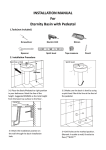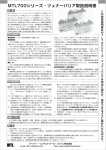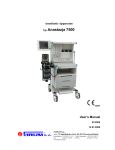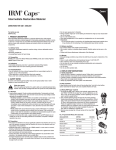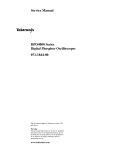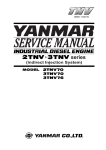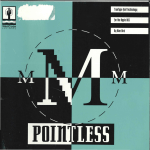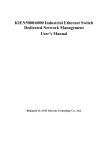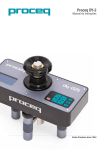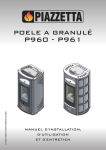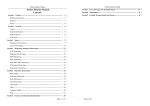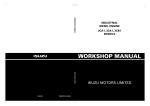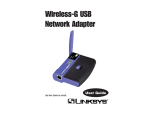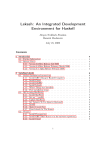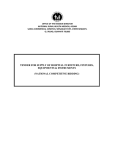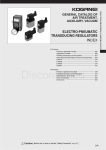Download 500E User Manual - Veterinary Technics
Transcript
Eternity IP300 Infusion Pump User’s Manual Beijing Eternity Electronic Technology Co., Ltd. 1 Statement Beijing Eternity Co, Ltd. (Eternity for short) holds the copyrights to this manual, which is non-publicly published, and reserves the rights to keep it as a secure document. Refer to this manual when operating, maintaining and repairing Eternity products only. Anyone other than Eternity may not make it known to others. Proprietary materials protected by the copyright law are included in this manual. Any section of it cannot be reproduced, copied, or translated into other languages without any prior written approval from Eternity who reserves the copyright. Everything written in this manual is considered to be correct. Eternity is not legally responsible for any mistakes printed within and any damages caused by incorrect installation and operation. Eternity does not supply privileges endowed by the patent law to any other parties. Eternity is not legally responsible for the results caused by patent law breaking and any rights of the third party violating. Refer to this manual before any Eternity product is used. The manual includes operating procedures which must be performed with cautiously, operations that may result in non-normal working conditions and the dangers which may damage equipment or cause bodily harm. Eternity is not responsible for the security, reliability and function of the equipments in case that the dangers, damages and non-normal phenomenon mentioned in this manual happen. Free repairs for these malfunctions will not be provided by Eternity. Eternity have the rights to replace any content in this manual without notice. Manufacturer Responsibility Eternity is responsible for the security, reliability and function of the equipments when to following conditions are adhered to: Installation, adjustments, mending and repairs must be performed by individuals authorized by Eternity; Necessary electrical equipment and the working environment must be in accordance with the national standards, professional standards and the requirements listed in this manual; Equipment must be used as instructed in the operating instructions. The paid theoretical framework diagram will be supplied according to customer requirements by Eternity, plus calibrating method and other information to help the customer, under the assistance of qualified technicians, repair the equipment parts where can be done by customer himself based on the stipulation by Eternity. 2 CAUTION: This equipment is not for family use. CAUTION: Malfunctioning equipment may become invalid and cause bodily injury if a set of effective and approving repairing proposals cannot be submitted by the institution which is responsible for using this equipment. Warranty Manufacturing techniques and materials: For a period of one year from the date of original delivery, the components and assemblies of this product is warranted to be free from defects manufacturing techniques and materials, provided that the same is properly operated under the conditions of normal use and regular maintenance. The warranty period for other parts is three months. Expendable parts are not included. Eternity’s obligation under the above warranties is limited to repairing free of charge. Free Obligations Eternity’s obligation under the above warranties does not include the freight and other fees; Eternity is not responsible for any direct, indirect or final product broken and delay which result from improper use, alteration by using the assemblies unratified and maintenance by anyone other than Eternity; This warranty does not apply to the followings: 1. Improper use 2. Machines without maintenance or machines broken 3. The label of Eternity original serial number or mark is removed or replaced 4. Other manufacturers’ product Security, reliability and operating condition Eternity is not responsible for the security, reliability and operating condition of this product in case that: The assemblies are disassembled, extended and readjusted This product is not operated correctly in accordance with the manual instruction. The power supply used or operating environment does not follow the requirements in this manual. Return Follow the steps in case that the product needs to be returned to Eternity: 1. Obtain the rights of return Contact with the customer service of Eternity by informing them the number and type of the product. The number is marked on the surface of the product. Return is unacceptable if the number cannot be identified. Enclose a statement of the number, type and the reason of return as well. 2. Transportation charges 3 Transportation and insurance charges must be prepaid by the user for transporting the product to Eternity for repairing. (Customers charges is added with regard to the products sold to non-Chinese mainland users) 4 Foreword Thank you for purchasing and utilizing Eternity equipment. For using the equipment rightly and effectively, please read throughtly and carefully the User Manual before use. Any use of the equipment requires full understanding and strict observation of these instructions. The equipment is only to be used for purpose specified here. One who is not authorized by Eternity shall not be allowed to open and dismantle the equipment for maintaining, checking and repairing. For further assistance contact Eternity, good service would be supplied. Welcome to contact Eternity by the following address: Manufacture: Beijing Eternity Co., Ltd. Address: No. 4, Xijing Road, Shijingshan District, Beijing, China.PR Tel.: +86 010 8879 5817 +86 010 88795560 Fax: +86 010 68827023 Web site: www.yshmed.com E-mail: [email protected] 5 PreCAUTIONs for use This equipment can only be used by professional. Do not open up enclosure to avoid electric shock. Any servicing or updating must only be performed by authorized by our company; the maintenance must be performed according to this manual. Perform the checking procedure before use. Error may be generated by using unspecified IV sets. The equipment interconnected with IP300 should be equipotential (protect earth line connection). It must conform to doctor’s advice to use BOLUS function in the process of infusion. If there is more than one infusion way to the patient, error may be generated for variable block-pressure in the pipes. Do not use cell phone near IP300, Or else, interfere generated from cell phone will affect infusion accuracy of IP300. Avoid sharing the same electrical outlet or over-close distance with high-power surgery equipment. Avoid using this equipment in the strong electric/ magnetic field surroundings. Operator must guarantee the patient safety when IP300 operated with other electrosurgery unit. The waste package must be performed according to current waste control rules and place it where the child can’t reach. Make sure alarm system normal to prevent infusion danger occurs. Make sure main supply protective earth line in good condition, if not, use battery supply. As auxiliary equipment for infusion, the management of medicament is answered by medical personnel. IP300 doesn’t belong to portable equipment. 6 1 Introduction ..........................................................................................................................................................................................9 1.1 What’s the IP300? .........................................................................................................................................................................9 1.2 Symbols ......................................................................................................................................................................................10 2 Structure .............................................................................................................................................................................................11 2.1 System components ....................................................................................................................................................................11 2.2 Front view ...................................................................................................................................................................................11 2.3 Rear view ....................................................................................................................................................................................12 2.4 Door-open view ..........................................................................................................................................................................13 2.4 Display screen ..............................................................................................................13 2.5 Indicator ......................................................................................................................................................................................16 2.7 Alarm Lights ...............................................................................................................................................................................16 2.8 Keypad ........................................................................................................................................................................................16 3 Performance Index..............................................................................................................................................................................20 3.1 Classification ..............................................................................................................................................................................20 3.2 Main Parameters .........................................................................................................................................................................20 4 Name Plate .........................................................................................................................................................................................22 4.1 Warning ......................................................................................................................................................................................22 4.2 Product information ....................................................................................................................................................................22 4.3 The correct installing infusion sets direction. (See figure 4-2).................................................................................................23 4.4 Other relevant accessories information in the IP300 ...................................................................................................................23 5 Installation of the IP300 infusion pump ..............................................................................................................................................24 5.1 Openpackage inspection .............................................................................................................................................................24 5.2 Fixation of the IP300 infusion pump...........................................................................................................................................24 5.3 Use the vertical infusion supports ...............................................................................................................................................24 5.4 Connect the AC power cord to the IP300....................................................................................................................................24 6 Install infusion sets ........................................................................................................................................................................25 6.1 Steps for installing infusion sets to the IP300 .............................................................................................................................25 7 Power on the IP300 ............................................................................................................................................................................29 7.1 Check the IP300 modes...............................................................................................................................................................29 8 Operation instruction ..........................................................................................................................................................................30 8.1 START OR STOP the IP300 ......................................................................................................................................................30 8.2 Power on self test ........................................................................................................................................................................30 8.3 Check the modes of the IP300. ...................................................................................................................................................31 8.4 remove the air in-line. .................................................................................................................................................................31 7 9 Set parameters ....................................................................................................................................................................................32 9.1 Set the volume preset value.........................................................................................................................................................32 9.2 Set the infusion rate ....................................................................................................................................................................32 9.3 Set types of the infusion set ........................................................................................................................................................33 9.4 Set the bolus rate .........................................................................................................................................................................34 9.5 Set the occlusion detector sensitivity levels ................................................................................................................................34 9.6 Infusion .......................................................................................................................................................................................34 9.6.1 Start up infusion ..................................................................................................................................................................34 9.6.2 Infusion rate units conversion..............................................................................................................................................34 9.6.3 Query the residual infusion volume .....................................................................................................................................35 9.6.4 Query the accumulated volume ...........................................................................................................................................35 9.6.5 Query the residual time of infusion process ........................................................................................................................35 9.6.6 Bolus infusion .....................................................................................................................................................................35 9.6.7 Heat function .......................................................................................................................................................................35 9.6.8 PAUSE function ..................................................................................................................................................................35 9.6.9 Alarms in the process of infusion ........................................................................................................................................35 9.6.10 Complete infusion .............................................................................................................................................................36 9.7 Others..........................................................................................................................................................................................37 9.7.1 Bolus ...................................................................................................................................................................................37 9.7.2 Alarms and trouble shooting for them. ................................................................................................................................38 9.7.3 Silence .................................................................................................................................................................................40 9.7.4 Heat malfunction alarm .......................................................................................................................................................40 10 Safety and Sign .................................................................................................................................................................................41 10.1 Environment safety ...................................................................................................................................................................41 10.2 Precautions for connecting ........................................................................................................................................................41 10.2.1 Check for liquid leakage ....................................................................................................................................................41 10.2.2 Three-way infusion............................................................................................................................................................42 10.2.3 Big difference from the drip rate .......................................................................................................................................42 10.2.4 Pharmacologic reactions ....................................................................................................................................................44 11 Monitoring performance ...................................................................................................................................................................45 11.1 Door monitoring........................................................................................................................................................................45 11.2 Occlusion monitoring................................................................................................................................................................45 11.3 Air in-line monitoring ...............................................................................................................................................................47 11.4 Empty monitoring .....................................................................................................................................................................47 11.5 Fault monitoring........................................................................................................................................................................47 11.6 Battery low monitoring .............................................................................................................................................................47 11.7 Power cut-off monitoring ..........................................................................................................................................................47 12 Cleaning and Sterilizing ...................................................................................................................................................................48 12.1 General cleaning .......................................................................................................................................................................48 12.2 Detergent...................................................................................................................................................................................49 12.3 Disinfecting...............................................................................................................................................................................49 13 User Maintenance .............................................................................................................................................................................51 13.1 Repair Policy.............................................................................................................................................................................51 13.2 Other Notice..............................................................................................................................................................................52 Annex I: .................................................................................................................................................................................................53 1 Accuracy test of the IP300 volumetric infusion pump(in accordance with standard EN60601-2-24)............................................53 2 Set rates: minimum rates 1mL/h ....................................................................................................................................................54 3 Inter-mediate rates 25mL/h ............................................................................................................................................................55 Annex II: ...............................................................................................................................................................................................57 8 1 Introduction 1.1 What’s the IP300? The IP300 (Infusion Pump 300) is a volumetric infusion pump which uses the microcontroller for accurate control of infusion rate and volume. Its infusion rate can be setup by the operator and be indicated by the liquid volume infused by the device in unit time. The infusion pump takes the linear peristaltic pump as its power source for liquid compression and is able to realize the active infusion under positive pressure without reliance on the gravity. It can monitor the air bubble and pressure in the pipe of infusion equipment. When the test value is higher than the set alarm value of infusion pump, the infusion pump shall give out the audio and visual alarm and stop the transfusion so as to guarantee the safety of infusion. If there is no power in the MAINS, the infusion pump shall automatically switch into the internal battery power supply and gives out the audio and visual alarms. Besides, when the infusion pump is defective or the door is being opened, the visual and audio alarms can be also given and the infusion shall be stopped. After infusion, the infusion pump shall give out the audio and visual alarms to prompt the operator that the infusion has been completed and meanwhile enter into KVO infusion. In addition, the IP300 infusion pump has the heat function to be used to heat the infusion sets tubing to warm the cold liquid in order to comfort the patients, prevent the cold liquid flow into patients’ body, and alleviate the irritation to patient body. IP300 infusion Pump is used in operating room, emergency unit, ICU, CCU, anabiosis room, ambulance and normal sickroom for infusion and nutrition supply. The operator of IP300 infusion pump should be medical staff who have relative professional knowledge and skill and also have been trained for using IP300 infusion pump. The installation and maintenance of IP300 infusion pump should be done by qualified service technician. Fig 1-1 IP300 infusion pump apparence WARNING: The user of IP300 must be professional and trained. 9 WARNING: IP300 is unsuitable for use in a magnetic resonance imaging (MRI) environment 1.2 Symbols WARNINGs and CAUTIONs indicate all the possible dangers in case of violation of the stipulations in this manual. Refer to and follow them. WARNING: Indicates potential hazards to operators or patients. WARNING: Indicates potential damage to equipment. Instead of illustrations, other symbols may also be utilized. Not all of them may necessarily appear in the equipment and manual. The symbols include: SN ON (Power from batteries) OFF Alternating Current Type BF equipment Direct Current Attention, consult accompanying documents Series Number GND Date of manufacture Silence Address of manufacturer 提示: Each Eternity product has a serial number, such as: IP300 xx xx xxx IP300: machine model E: machine model for exporting the first xx : the year of manufacturing the second xx : the month the third xxx : equipment number 10 (Power from batteries) 2 Structure 2.1 System components 1. Main unit: Peristaltic pump, display screen, surface film, control board, power board, sensor, rechargeable battery, pile module, enclosure. 2. Accessories: fuse, power supply cord, and user’s manual. 3. Consumables: Single used infusion sets (users buy it themselves with manufacturer authorized type). 2.2 Front view 4 2 1 7 6 5 3 Fig 0-1 IP300 Front view 1 Display screen 2 Indicators 3 Speaker 4 Alarm lights 5 Door switch 6 Key pad 7 Fixation case 11 2.3 Rear view 1 2 3 4 Fig 0-2 IP300 Rear view 1 nameplate 2 Power Socket 3 Power Socket 4 Fuse installed site Power supply: 100~240VAC, 50Hz/60Hz fuse:F500mAL250V Equipotential terminal: connected to equipotential terminal in other equipments with special cable, or connected to protective ground by operator if the mains supply used without equipotential terminal. WARNING: If the power cord cannot connect to the ground, the infusion pump equipotential terminal has to connect to the ground correctly. 12 2.4 Door-open view Thermostat inside this component 13 2.4 Display screen Display screen contains 4 areas, which are shown in the Fig 2-3:①Alarm message area, ② status information area, ③ parameters area, ④ information options area and accumulated volume display value area. Area 1 Area 2 Area 3 Area 4 Fig 0-3 IP300 Frontview Area 1: Alarm message area When alarm occurs, the corresponding icon will be blinking to remind operator to deal with alarm. More details refer to chapter 4. Fault alarm icon. When fault alarm triggered, this icon is blinking, and alarm occurs accompanying audible and visible. Must shutdown the pump and restart when fault alarm occurs. However, if the infusion rate≤5mL/h, there is not KVO mode after infusion process completed. Occlusion alarm icon. When patient tube pressure more than presetting, the occluded alarm is triggered, and its icon is blinking, the alarm is visible and audible, the pump stop infusing at the same time. If the occlude is removed, the occluded alarm icon disabled. Door-open alarm icon. When the pump door is open, the door open alarm is triggered, and the icon blinking. If the pump door closed, the icon disabled. The door open alarm occurs with audible and visible in the process of infusing and without audible in non-infusion state. Air in-line alarm icon. When bubble in the IV line exists and is detected by ultrasonic sensor, the bubble alarm occurs, and its icon blinking, audible and visible accompanied. The pump stops infusing at the same time. If the bubble is removed, the bubble alarm icon disabled. Low battery voltage alarm icon. When the pump is powered by battery supply only, and residual capacity can not ensure the pump continuous operating, the low battery alarm is triggered, at the same time the relevant icon blinking and alarm works with audible and 14 visible information. Empty alarm icon. When medicine liquid infused reaches presetting, the pump will turn to KVO state automatically, empty alarm icon blinking, meanwhile the empty alarm is visible and audible. KVO (keep vein open) alarm icon. When infusion finished, the pump turns to KVO state automatically. The KVO alarm icon and empty alarm icon will be blinking synchronously. Area2: status information area Audio alarm icon: When the audio alarm is triggered, this icon is lit; if the audio alarm is eliminated or the equipment was silenced, this icon is absent. Outer AC supply icon: When the pump is powered by outer AC supply, this icon is lit; If the AC supply is cut off, this icon is blinking and the IP300 system also triggers audio alarm. Battery capacity and charging icon: When the battery is charging, the four lines in this icon will be lit from the bottom up in turns until battery charging finish. And after battery charging finished, the four lines in this icon would be lit at the same time. In addition, this icon can indicate the current capacity of the battery and the number of the lines indicate amount of the capacity of the battery. If the capacity of the battery is nearly exhausted or at low voltage, this icon is blinking. Alarm silence icon: If audio alarm occurs, press Silence key and then this icon will be present, meanwhile audio alarm is eliminated. This icon is absent when alarm silence is canceled. If the temperature of environment is very cold, the users can start up the heat function. In addition, if the users select the HEAT-ON mode, the heat function will be continuously on, and this icon is also lit. If the users select the HEAT-OFF mode, the heat function will stop, and this icon is absent. If the users select the HEAT-AUTO mode, the heat function will start up according to the environment temperature(<16±3℃) to decide to start up the heat function, and this icon will keep the same action with the heat function. Area3: parameters area This part displays: 1. Volume preset value 2. Residual volume 3. Preset time and residual time 4. drip chamber indicates whether the infusion is proceeding This part displays: 1. infusion flow rate and the unit can be converted between drip/min and ml/h Area4: information options area and accumulated infusion volume display value area. 15 There are IV sets options: tubing types options, adjustment options, BOLUS rate options, occlusion detector sensitivity level options from left to right in turns. When the parameters are selected, the black frame of these parameters will be blinking. In addition, on the right of this area, there is accumulated infusion volume display value area 2.5 Indicator AC AC( alternating current ) When the pump is powered by outer AC supply, this Indicator indicator is lit green; If the AC supply is cut off, this icon is dark. DC DC (direct current) Indicator When the pump is powered by inner rechargeable battery supply, this indicator is lit green; If the AC supply is on and battery is being charged, this indicator is lit yellow. If the battery power is completely exhausted and AC power supply is cut off, this indicator is dark. HEAT HEAT Indicator ON OFF AUTO According to the Heat function modes, the indicator will be lit green or dark related to the modes the users select. 2.7 Alarm Lights When the alarm occurs, the alarm lights are blinking to remind operator to deal with it in time. 2.8 Keypad Power key. As a soft switch key for power supply, it can realize the power-on/off functions. When this key is pressed down, the transfusion pump can be powered on and get in the standby mode. After the work has been completed, the transfusion pump can be powered off if this key has 16 been pressed down for more than 3 seconds. Pressing this key for 3 seconds, users can get in the IV sets options mode and types of “tubing”, “Bolus” rate, and “Occlusion” detector sensitivity level can be set by the users if necessary. Users can press this to select 3 different heat function mode: on, off, auto, if necessary. In the standby mode, users can press this key to set the volume preset value. In the standby mode, users can press this key to set the flow rate. In the standby mode, if users need bolus infusion or remove the liquid in the infusion set tubing, users can press and hold“Bolus” key for more than 3 seconds to do it. But if the users relieve the key, the equipment gets into the standby mode. This key is “Silence” key. When alarm is given and it is necessary to stop the audio alarm, it can stop the audio alarm if this key is pressed. This key is a “START/STOP” key. When the operating parameters have been set and this key is pressed down, the transfusion pump shall start the infusion in accordance with the internally-set parameters. When it is necessary to stop the infusion after completion of infusion or occurrence of other cases, press down this key to stop the transfusion. Press this key to eliminate current input in the mode of parameters settings. In the standby mode, press this key for 2 seconds to eliminate accumulated value of infusion volume. In the mode of parameters settings, press this key can conform the current input value. Or, pause the infusion process with pressing this key in the running status for 3 seconds. In the mode of parameters settings, press this key to input "1"; In the mode of selecting infusion set tubing types, press this key to select NO.1 infusion set ( the manufacturer specified infusion set); In the mode of selecting Bolus rate, press this key to select Bolus rate 600mL/h; In the mode of selecting the level of occlusion sensivity, press this key to select 1st level (0.04Mpa±30%). In the mode of parameters settings, press this key to input "2"; In the mode of selecting infusion set tubing types, press this key to select NO.2 infusion set; 17 In the mode of selecting Bolus rate, press this key to select Bolus rate 700mL/h; In the mode of selecting the level of occlusion sensivity, press this key to select 2nd level (0.06Mpa±30%). In the mode of parameters settings, press this key to input "3"; In the mode of selecting infusion set tubing types, press this key to select NO.3 infusion set; In the mode of selecting Bolus rate, press this key to select Bolus rate 800mL/h; In the mode of selecting the level of occlusion sensivity, press this key to select 3rd level (0.09Mpa±30%). In the mode of parameters settings, press this key to input "4"; In the mode of selecting infusion set tubing types, press this key to select NO.4 infusion set; In the mode of selecting Bolus rate, press this key to select Bolus rate 900mL/h; In the mode of selecting the level of occlusion sensivity, press this key to select 4th level (0.12Mpa±30%). In the mode of parameters settings, press this key to input "5"; In the mode of selecting infusion set tubing types, press this key to select NO.5 infusion set; In the mode of selecting Bolus rate, press this key to select Bolus rate 1000mL/h; In the mode of selecting the level of occlusion sensivity, press this key to select 5th level (0.15Mpa±30%). In the mode of parameters settings, press this key to input "6"; In the mode of standby and running, press this key to convert the unit between “ml/h” and “drip/min” In the mode of parameters settings, press this key to input "7"; In the mode of standby, press this key to see the preset time and in the running mode, press this can see the left time ( or residual time of the process of infusion). 18 In the mode of parameters settings, press this key to input "8"; in the running mode, press this can see the left amount of the current infusion volume ( or residual amount of the current process of infusion volume). In the mode of parameters settings, press this key to input "9"; In the mode of parameters settings, press this key to input "0"; In the mode of parameters settings, press this key to input a decimal point "."; 19 3 Performance Index 3.1 Classification According to EN 60601-1: 2006, IEC 60601-1: 2005 Medical electrical equipment - Part 1: General requirements for basic safety and essential performance, IP300 belongs to the following classifications: Class I equipment Type BF equipment General equipment With internal battery Operate continuously According to EN 60601-2-24: 1998, IEC 60601-2-24: 1998 Medical electrical equipment - Part 2-24: Particular requirements for the safety of infusion pumps and controllers, IP300 belongs to the volumetric infusion pump and it cannot be used as portable equipment. 3.2 Main Parameters 1) Overall size: 245×180×170(mm) (H×D×W); 2) Weight: 2.4Kg 3) Operating environment: a) b) c) d) Temperature: +5℃ ~ +40℃ Relative humidity: 20%~90% Atmospheric pressure: 70kPa ~ 106kPa Power supply: I) AC100V~240V, 50/60HZ; II) rechargeable battery: Ni-MH (Model Number.: Kan AA (49) battery 9.6V: Zhejiang Suichang Kan Battery Co., Ltd. 4) Storage &Transportation: If there is no definite demands and declaration, IP300 infusion pump should Storage& Transportation according to these demands: a) b) c) d) 5) 6) 7) 8) 9) 10) Environment temperature range: -20 ℃~+55 ℃ Relative humidity: ≤93% atmospheric pressure: 50 kPa~106 kPa Other demands: No contacting with corrosive gases and well ventilated room. Patient type: Adult, Pediatric and neonatal Driving mode: electrical motor drive Flow rate setting range: 1mL/h~1300mL/h, minimum step: 1ml/h Maximum preset volume range: 1mL~9999 mL Maximum accumulated infusion volume display value range: 1mL~9999 mL KVO rate: 20 11) 12) 13) 14) a) 1mL/h≤flow rate≤5mL/h, when finish infusion process, the IP300 stop running and comes back to the standby mode. b) 5mL/h<flow rate<50mL/h, KVO rate is 1mL/h. c) 50≤flow rate<300 mL/h, KVO rate is 3mL/h. d) 300≤flow rate≤1300 mL/h, KVO rate is 5mL/h. Accuracy of the set delivery rate: ±5% over 4 hours with specified infusion sets(users buy it themselves with manufacturer authorized type). Bolus rate: 600 mL/h, 700 mL/h, 800 mL/h, 900 mL/h, 1000 mL/h, be selectable if the situation requires. Air sensor sensitivity: ≥0.015mL Occlusion detector sensitivity: Adjustable in 5 levels from 0.04Mpa~0.015Mpa±30% a) b) c) d) e) 15) 16) 17) 18) 19) 20) 21) 5th 4th 3rd 2nd 1st Level: Level: Level: Level: Level: 0.04Mpa±30% 0.06 Mpa±30% 0.09 Mpa±30% 0.12 Mpa±30% 0.15 Mpa±30% The number of the air sensors: 2 sets The number of the occlusion detector: 1set The number of the heat function equipment: 1set Heat function modes: 3 options: Auto, On, Off Heat temperature on the spring board: 30±5℃ Display screen: colorful LCD screen Specified infusion sets: Anaco Disposable infusion sets H-05APD 22) Input power: ≤0.5A 23) Alarms: Internal Fault, Low Battery voltage, AC Failure, Door Open, Occlusion, Air in-line, empty, Heat malfunction, Interruption of the AC power supply. 24) Alarm Volume: Alarm volume should be over 65dB (A) during alarms. 25) Pump Running Noise: Without Alarms, IP300’s running noise should be under 50dB (A). 26) Battery Capability: Infusion Pump can run under intermittent rate (25mL/h) longer than 4 hours (at 20℃). 27) Charging: AC Power charges automatically. Electric quantity could achieve over 85% after charging for 6 hours. 28) The time for which the electronic memory is retained follow switch off or power off: 10 years. 29) The maximum volume that may be infused under single fault conditions: ≤1mL 21 4 Name Plate 4.1 Warning IP300 infusion pump should be used with the manufacturer specified infusion sets. If users use other infusion sets that are not specified by the manufacturer, should calibrate the equipment. But the manufacturer is not responsible for the inaccuracy of infusion. Don’t use the IP300 in the environment of strong RFI or electromagnetic radiation. For example, the IP300 should be far more than 0.5m from high frequency surgical instrument when being used; far from NMRI, CT, X-Ray, microwave equipments.etc. (See the figure 4-1) 4.2 Product information Product Name, Product Model, Product Registration Number, Product Standard Number, Product Series Number, date of Manufacture, Manufacturer Name, Address of Manufacturer, and Power supply Demands. Figure 4-1 Nameplate 22 4.3 The correct installing infusion sets direction. (See figure 4-2) Figure 4-2 4.4 Other relevant accessories information in the IP300 Thermostat information Rechargeable battery information Thermostat: 30±5℃; 2W/15V, with Over-temperature protection apparatus Rechargeable battery: Ni-MH battery 9.6V/ 1500mAh; with 65℃over-temperature protection and 2A overcurrent protection apparatuses 23 5 Installation of the IP300 infusion pump 5.1 Openpackage inspection Be careful to take out the IP300 infusion pump and accessories from the package, and preserve the package to prepare for the transportation and storage in some day. Also, the user should check things according to the configures of equipment list. Check no damage to the IP300 infusion pump and its accessories。 Check things and make sure these is nothing missing and everything is qualified. If users find there are some problems with the products, please contact the manufacturer immediately. 5.2 Fixation of the IP300 infusion pump 2 fixation modes of the IP300 infusion pump: a) Fix the infusion pump to the vertical infusion support. b) Put the infusion pump on the table. If the users require the vertical infusion supports for infusion pumps, the manufacturer can equipped the IP300 infusion pumps with these infusion supports. 5.3 Use the vertical infusion supports Fix the fixation case to the right height of the infusion supports, where is 0.5m higher above hospital beds or 1.2m higher above the floor. CAUTION: When fix the IP300 to the infusion supports, the user should fasten the screw in the fixation case and check it to keep the infusion pump firm and stable. 5.4 Connect the AC power cord to the IP300 Steps for connecting the AC power cord Make sure the power supply accord to: 100~240VAC, 50 Hz/60Hz Use accompanying and right power cord to connect AC power supply. Connect equipotential line necessarily. CAUTION: The equipments after long-time transportation and storage, should charged for the inner battery. Thus, connect the equipments to AC power source, switch on and the equipments can get in the auto charging and managing battery mode. 24 6 Install infusion sets WARNING: The manufacturer does not recommend other bands of infusion sets that are not specified by the manufacturer. If the users cannot use or buy the specified infusion sets, the users should calibrate the infusion pump flow rate accuracy. However, the manufacturer cannot make sure that the infusion flow rate accuracy meets the demands of ±5% or ±10%, and the manufacturer is not responsible for relevant medical malpractice as a result of the use non-specified infusion sets. If continuous using a infusion set, the user should change the infusion set tubing compressed site by the peristaltic pump every four hours. Infusion sets should be disposable and only used once independently. CAUTION: The manufacturer specified infusion sets are shown as follows: Types of manufacturer Performance Index infusion sets 1 Tianjin Hanaco medical CO., Ltd 20 drips/(ml±0.1ml) 2—5 Tianjin Hanaco medical CO., Ltd 20 drips/(ml±0.1ml) Other spec demands:inside diameter:Φ 3.0mm, outside diameter:Φ 4.0mm Disposable infusion sets H-05APD 6.1 Steps for installing infusion sets to the IP300 First, connect the infusion set to infusion bottle, and make the drip chamber half full of liquid. Then, adjust the flow regulator until the liquid flow out of injection site. Next, adjust the flow regulator to stop the liquid flowing. 1. Install the infusion set tubing. a) Open the door of the infusion pump: Pull the door switch, as being shown in the fig 6-1. 25 Fig 6-1 pull the door switch Open the door, as being shown in the fig 6-2. Fig 6-2 open the door b) Install the tubing Select the right site of the infusion set tubing, install it from top down in the grooves, straighten the tubing and make sure there are no any mistakes. Then push the clamp which is for stopping the flow, install and clamp the tubing. Users make sure that the clamp functions well, and no flow moves freely. As being shown in the fig 6-3. 26 Figs 6-3 install tubing c) Close the door. As being shown in the fig 6-4. Fig 6-4 close the door 2. Connect to the paitent. a) Before installing the tubing, make sure no air in line. b) After installing the tubing, adjust the infusion set flow regulator and loosen it to make sure no liquid drips out of injection needle or into drip chamber. If some liquid drips out of injection needle or into drip chamber, it indicates that wrong installing the infusion set tubing and the user need to install tubing right again. However, if the user makes sure it is right installing tubing, it would be the malfunction of the equipment and solve these problems according to the trouble shooting in the instruction. If everything is OK, the user fasten and close the flow regulator. 27 c) Make sure that no air in the line ( or in the tubing), and then remove the protective cap of needle and pierce needle into the patient’s vein carefully. Finally, make sure that the IV needle pierces safely. CAUTION: If wrong installing or not closing the door of the IP300, alarms cannot work properly or flowing abnormally. In addition, maybe the infusion relevant monitoring fails. Users should use the manufacturer specified infusion set and install it according to the user’s manual. If users cannot operate to base on these demands, maybe the effect and accuracy of infusion expectation cannot achieve. 28 7 Power on the IP300 Press the power key and switch the IP300, the IP300 ring audio alarm accompanying the alarm lights and indicator blinking twice. In the meantime, LCD screen is displaying all the information. After twice audio alarms, LCD is displaying normal information. When AC supplies on, rechargeable battery can get in the auto charging and managing mode. Then, the user can operate the IP300. WARNING: If the user finds the “Fault” alarm or damage of the IP300, please do not use it for infusion to patients, and contact the equipment maintenance operators or the manufacturer. Check all the functions of the IP300, make sure that the IP300 can run normally. Every time after finish the infusion, users should connect the IP300 to the AC power supply source to make the equipment battery being charged, and the battery supply has enough power to support the IP300 running. 7.1 Check the IP300 modes Check the alarm lights: When switch on the IP300, the alarm light blink twice and then return to normal Check the audio alarm: When switch on the IP300, the audio alarm rings twice and then return to normal Check the display screen: When switch on the IP300, display screen shows all information such as parameters, alarms and statuses. And then return to normal. If the user find the information displays incompletely, please contact the manufacturer. Check the air sensors: If put no infusion set tubing in the groove of the air sensors, or wrong way to install the tubing, or the infusion set tubing has some bubbles in it, the IP300 will trigger the air in-line visual alarm and show it to the users. If put the tubing in which no air in it and liquid fills up, the visual alarm will be absent, and it indicates the air sensors function well. Check the Occlusion detector: When right way to put the infusion set tubing, which is filled up with liquid, into the grooves, and close the door, press the “ START/STOP” key to get in the running mode. At this time, users occlude the tubing, then the occlusion alarm is triggered, it indicates the occlusion detector functions well. Check the door-open detector: 29 In the standby mode, when open the door, the visual alarm of door-open is triggered. If open the door in the mode of running mode, the visual and audio alarm will be triggered at the same time. Check the clamp which is for stopping the flow: After finish installing the infusion set, make the clamp infibulates the tubing and no flow moves freely. And, push the clamp, the flow in the tubing can move freely, it indicates that the clamp function well. Check the free flow: After finish the installation, close the door of the IP300, and make the IP300 stable. At this time, users can watch the drip chamber and infusion set needle to see whether some drips move freely due to the effect of gravity. If no any free flow, it indicates that the infusion flow is controlled well. 8 Operation instruction 8.1 START OR STOP the IP300 The IP300 power can be supported by AC and inner battery. When the IP300 connect to the AC power, the inner rechargeable battery will be being charged automatically. If the IP300 doesn’t connect to the AC power source or be cut off, the user can start the IP300 by the inner rechargeable battery completely. 8.2 Power on self test 1. When the IP300 is power on, it starts the self-test, and peristaltic pump cannot run. 2. In the process of self test, the display screen shows all the information about the IP300 to assure the display system functions well. In the meantime, the IP300 gives twice audio and visual alarms to assure the alarms system functions well. 3. If the process of the power on self test finishes, the IP300 get into the standby mode. 30 4. If the alarms system doesn’t function well, users can solve the IP300 according to the information of the user’s manual. If users cannot solve problems, please contact the maintenance operator in hospital or the manufacturer. 8.3 Check the modes of the IP300. Check the modes according to Chapter 7.1 。 8.4 remove the air in-line. 1) Remove the air in-line by gravity. Steps for operation: a) Insert the piercing needle into the infusion bottle, close the flow regulator, and then hang the infusion bottle on the infusion support, and have the infusion set natural downward extension. b) Open the flow regulator to make the liquid flow fill up the infusion set tubing by gravity to remove the air in the tubing and also use the hand to pinch the drip chamber to make liquid fill from 1/2 to 2/3 volume of the drip chamber. c) After completely remove air in the tubing, close the flow regulator. d) Right installation of infusion set according to Chapter 6.1 e) Make sure that the tubing has no air in it and insert disposal vein infusion needle into the patient’s vein in the right way. f) Open the flow regulator and start up the IP300 to run. CAUTION: The flow regulator should between the infusion pump’s site where the liquid flows out and the injection site in order to control the process of bolus or infusion by manual operation. When pinch the drip chamber to fill liquid, do not get the air in the infusion set tubing. After installing the infusion set and opening the flow regulator, see whether some drips drip down in the chamber or vein infusion needle. If some abnormal phenomena exist, check the ways of installing. However, if users cannot solve these abnormal phenomena, don’t start up the IP300 and contact the maintenance operators or the manufacturer. 2) Remove the air in-line by bolus function Steps for operation: a) Insert the piercing needle into the infusion bottle, close the flow regulator, and then hang the infusion bottle on the infusion support, and have the infusion set natural downward extension. b) Open the flow regulator to make the liquid flow fill up the infusion set tubing by gravity and also use the hand to pinch the drip chamber to make liquid fill from 1/2 to 2/3 volume of the drip chamber. c) Close the flow regulator. d) Right installation of infusion set according to Chapter 6.1 e) Open the flow regulator and start up the IP300 to run. f) If there is still some air in the tubing, users should press and hold the “Bolus” key for more than 3 seconds to remove all the air in-line. 31 g) Make sure that the tubing has no air in it and insert disposal vein infusion needle into the patient’s vein in the right way. CAUTION: The flow regulator should between the infusion pump’s site where the liquid flows out and the injection site in order to control the process of bolus or infusion by manual operation. When pinch the drip chamber to fill liquid, do not get the air in the infusion set tubing. After installing the infusion set and opening the flow regulator, see whether some drips drip down in the chamber or vein infusion needle. If some abnormal phenomena exist, check the ways of installing. However, if users cannot solve these abnormal phenomena, don’t start up the IP300 and contact the maintenance operators or the manufacturer. 9 Set parameters 9.1 Set the volume preset value In the standby mode, Press the “VOL.LIMIT” key, the area of volume preset value displays “0000” which is also blinking. And the IP300 get the standby mode into the mode of setting the volume preset value; screen displays “VOL.LIMIT” and “ml”; press relevant “0~9” digital keys to set the volume preset value ( For example, if users want to input “4321ml”, they can press “4”, “3”, “2”, and “1” keys.) Then, press “ENTER” key to save the current input. If users just input data without any operation or “ENTER” subsequently beyond 10 seconds, the current input is saved automatically. In addition, users can press “VOL.LIMIT” key to exit the mode of setting the volume preset value. After starting up the IP300 and running it, if users want to reset the parameters, users need to stop running the IP300, and then press “VOL.LIMIT” to get in the mode of setting. The preset volume range is: 1ml~9999ml, the minimum step is 1ml. 9.2 Set the infusion rate In the standby mode, press the “RATE” key, the area of the infusion rate value displays “0000” which is also blinking. And the IP300 get the standby mode into the mode of setting the rate; screen display “Infusion Rate” and the relevant rate unit; press relevant “0~9” digital keys to set the infusion rate value(For example, if users want to input “123”, they can press “1”, “2” and “3” keys.) Then, press “ENTER” key to save the current input. If users just input data without any operation or “ENTER” subsequently beyond 10 seconds, the current input is saved automatically. In addition, users can press “RATE” key to exit the mode of setting the infusion rate value. After starting up the IP300 and running it, if users want to reset the parameters, users need to stop running the IP300, and then press “RATE” to get in the mode of setting. 32 The rate range is: 1ml~9999ml, the minimum step is 1ml/h. CAUTION: The IP300 is just an auxiliary equipment. So, the medical personnel has to be responsible for the medical content of the infusion liquid Set the right infusion volume and rate value according to the physician or doctor in charge If an infusion set is connected with the three-way connector and carried out the combined infusion with another way (as shown in figure 9-1), attentions must be paid to taboo at matching of two medicines or more. Besides, since the liquid from another infusion line( or IV line) may have a minor resistance on the infusion set on the infusion pump, the accuracy may exceed the stipulated tolerance. Infusion bottle Infusion bottle Drip chamber Drip chamber Infusion pump IV line Three-way connector Figure 9-1 9.3 Set types of the infusion set In the standby mode, press and hold “SETTING” key for 2 seconds, at this moment, in the LCD screen, “TUBE”, “BOLUS” and “OCCL.” icons is blinking. And then, press the relevant “1” key, the IP300 system can get into the setting types of “TUBE” mode. In this mode, “1TUBE” is the manufacturer specified infusion set. But, “2”, “3”, “4”, “5” TUBES are other infusion sets that can be specified by the users themselves. Users can select these set by pressing relevant digital key and press “ENTER” to confirm the selected information. If users just input data without any operation or “ENTER” subsequently beyond 10 seconds, the current input is saved automatically. In addition, users can press “SETTING” key to exit the mode of setting the types of the infusion set. 33 9.4 Set the bolus rate In the standby mode, press and hold “SETTING” key for 2 seconds, at this moment, in the LCD screen, “TUBE”, “BOLUS” and “OCCL.” icons is blinking. And then, press the relevant “2” key, the IP300 system can get into the setting the bolus rate. In the IP300 system, there are 5 rates options can be selected: “600ml/h, 700ml/h, 800ml/h, 900ml/h, 1000ml/h” and users can press relevant digital key “1”, “2”, “3”, “4”, “5” to select required bolus rate. After finish selecting rate, users can press “ENTER” to confirm the selected information. If users just input data without any operation or “ENTER” subsequently beyond 10 seconds, the current input is saved automatically. In addition, users can press “SETTING” key to exit the mode of setting the bolus rate. 9.5 Set the occlusion detector sensitivity levels In the standby mode, press and hold “SETTING” key for 2 seconds, at this moment, in the LCD screen, “TUBE”, “BOLUS” and “OCCL.” icons is blinking. And then, press the relevant “3” key, the IP300 system can get into the setting the occlusion detector sensitivity levels. “5”, “4”, “3”, “2”, “1” keys individually indicate relevant occlusion detector sensitivity levels. After finishing selecting, press “ENTER” to save the current input. If users just input data without any operation or “ENTER” subsequently beyond 10 seconds, the current input is saved automatically. In addition, users can press “SETTING” key to exit the mode of setting the occlusion detector sensitivity levels. CAUTION: In the mode of setting volume and rate, press “CLEAR” can clear the current input. In the mode of setting volume and rate, press “ENTER” but without any digital input, the system confirm the original parameters automatically. 9.6 Infusion 9.6.1 Start up infusion After finishing all process of installing infusion set and check of the IP300, press “START/STOP”key and the IP300 start working. At this moment, the icons, drip chamber and drips begin to display and drips are blinking from top down in turn. It indicates that the process of infusion is going on. 9.6.2 Infusion rate units conversion. In the standby or running mode, pressing “6” key can convert the units. At this time, the LCD screen can convert unit “ml/h” into “ /min” ( drip/min). After 3 seconds, the infusion rate unit goes back to “ml/h”. CAUTION: A statement that the infusion set is like this that 20 drips of distilled water delivered by the drip tube are equivalent to a volume of (1±0.1) ml or a mass of (11±0.1)g Because of the different qualities of different infusion sets and different 34 properties of the different medical liquid, there is error between the display consequence of different units 9.6.3 Query the residual infusion volume In the standby or running mode, pressing “8” key can query the residual infusion volume. At this time, the LCD screen can display “LEFT”, residual infusion volume value and “ml”. After 3 seconds, displaying information goes back to “VOL.LIMIT”, infusion volume preset value and “ml”. 9.6.4 Query the accumulated volume In any mode, users can query the accumulated volume from the Bottom-right of the display screen. 9.6.5 Query the residual time of infusion process In the standby or running mode, pressing “7” key can query the residual time of infusion process. At this time, the LCD screen displays “LEFT”, residual time and “min”. After 3 seconds, display information goes back to “Infusion Rate”, infusion rate value and “ml/h”. 9.6.6 Bolus infusion Bolus infusion is used for rapid infusion (discrete quantity of liquid which is delivered in a short time) and removing air in-line. Operation process can refer to Chapter 8.4. 9.6.7 Heat function The cold temperature can affect the infusion accuracy and increase the irritation to the patients’ body. So the heat function can solve all these problems. Users can press the “HEAT” key to select the modes of heating, such as “ON” mode, “OFF” mode and “AUTO” mode. If the users select the HEAT-ON mode, the heat function will be continuously on. If the users select the HEAT-OFF mode, the heat function will stop. If the users select the HEAT-AUTO mode, the heat function will start up according to the environment temperature(<16±3℃) to decide to start up the heat function, and this icon will keep the same action with the heat function. Heat temperature on the spring board: 30±5℃ 9.6.8 PAUSE function If the user wants to pause the infusion, press “ ” for 3 seconds in the running status and the IP300 will save the data before this key is pressed. And If the user wants to restart the infusion process, press “START/STOP” again according to the data that have been saved before pause. 9.6.9 Alarms in the process of infusion 1) In the process of infusion, these alarms might be triggered: 2) There is air in the infusion set tubing: Air in-line alarm 3) The door of the IP300 is open or the door is not well closed completely: Door open alarm 35 4) The pressure in the infusion tubing exceeds the occlusion sensitivity levels: Occlusion alarm 5) Electrical step motor’s fault or pump mechanical malfunction or occlusion detector’s failure: inner Fault alarm 6) The residual power of rechargeable battery cannot support the IP300: low battery voltage alarm 7) Finish the infusion: Empty of infusion volume and KVO mode starts up 8) AC power is cut off: AC cut off alarm These information and the resolution of alarms can refer to 9.7.2。 9.6.10 Complete infusion When finish infusion and the preset volume is empty, the alarm ( ) in the LCD screen is blinking with audio alarm triggered and indicates that infusion process is completed, and the IP300 gets into the mode of KVO (keep vein open). 9.6.10.1 Avoid thrombus When finish infusion and the preset volume is empty, KVO starts up to infuse patients to prevent the thrombus from appearing, and also, the audio alarm is reporting continuously. KVO alarm icon ( ) is blinking. However, if the infusion rate≤5mL/h, there is not KVO mode after infusion process completed. KVO rate: a) 1mL/h≤flow rate≤5mL/h, KVO rate is OFF. b) 5mL/h<flow rate<50mL/h, KVO rate is 1mL/h. c) 50≤flow rate<300 mL/h, KVO rate is 3mL/h. d) 300≤flow rate≤1300 mL/h, KVO rate is 5mL/h. 9.6.10.2 Restart infusion If users need to restart infusion again, they have to operate according to the following steps: Accumulated volume value is zero clearing. 1) In the standby mode, press “CLEAR” key for 2 seconds to clear accumulated volume value. 2) If need to reset new parameters, press “VOL.LIMIT” key and “RATE” key to reset the infusion volume preset value and infusion rate. 3) Press “START/STOP” key to restart infusion. Accumulated volume value plus the new volume preset value 1) If need to reset new parameters, press “VOL.LIMIT” key and “RATE” key to reset the infusion volume preset value and infusion rate. 2) Press “START/STOP” key to restart infusion. 36 9.6. 10.3 Stop infusion. In the KVO mode, when finish and want to stop infusion, press “START/STOP” to go back to the standby mode. (However, Alarms icons that ( ) and ( ) are absent. Now, the user can draw the vein infusion needle out of the patient’s body. Then, open the door of infusion pump, push the clamp to draw out the infusion set, pull the tubing out of grooves, and do well the nursing work, power off the IP300. CAUTION: Even though the AC power is cut off, the IP300 can still work by the inner rechargeable battery. If the infusion rate≤5mL/h, when finish infusion, the IP300 system do not get into the KVO mode. So, users can press “silence” key to make the IP300 go back to the standby mode. 9.7 Others 9.7.1 Bolus Discrete quantity of liquid which is temporarily delivered in a short time. In the standby mode, press and hold “SETTING” key for 2 seconds, at this moment, in the LCD screen, “TUBE”, “BOLUS” and “OCCL.” icons is blinking. And then, press the relevant “2” key, the IP300 system can get into the setting the bolus rate. In the IP300 system, there are 5 rates options can be selected: “600ml/h, 700ml/h, 800ml/h, 900ml/h, 1000ml/h” and users can press relevant digital key “1”, “2”, “3”, “4”, “5” to select required bolus rate. After finish selecting rate, users can press “ENTER” to confirm the selected information. If users just input data without any operation or “ENTER” subsequently beyond 10 seconds, the current input is saved automatically. In addition, users can press “SETTING” key to exit the mode of setting the bolus rate. In the standby mode, press and hold “BOLUS” key for more than 3 seconds, the bolus mode start and release the key, the bolus mode stop and go back to the standby mode. However, bolus volume is not calculated and added to the accumulated volume. WARNING: Before use bolus function, users should check the infusion liquid’s medical property in order to avoid some harmful medical influence to patients’ bodies. When bolus mode starts up, the air-line alarm, occlusion alarm and door-open alarm do not work. 37 9.7.2 Alarms and trouble shooting for them. 1) Air in the infusion set tubing: AIR in-line alarm ( ) Alarm status: a) In the standby mode, relevant icon blinking. b) If in the running mode, this alarm is triggered, even more accompanying alarm lights hinting and audio alarm. Consequence of the alarm: the IP300 stop running. Trouble shooting: press the silence key “ ” to stop audio alarm and the IP300 will restore previous status and data automatically. Then, open the door of the IP300, draw out the infusion set tubing and remove the air bubble by manual operation. Then, right installing the tubing, close the door to see whether the air in-line alarm disappears; Or, bolus function to remove the air. Finally, press “START/STOP” to restart infusion. 2) The block pressure exceeds the occlusion detector sensitivity levels: Occlusion alarm ( Alarm status:Relevant icon blinking, if in the running mode, this alarm is triggered, accompanying alarm lights hint and audio alarm. ) Consequence of the alarm: the IP300 stop running. Trouble shooting: press the silence key “ ” to stop audio alarm and the IP300 will restore previous status and data automatically. Open the door. Check whether the infusion set needle rightly injected into the patient’s body. If wrongly injected, the infusion set needle should be wrong injected by the users. If the tubing is blocked or bended, the user should straighten the tubing to keep the liquid flowing smoothly. Close the door to see whether the occlusion alarm disappears. Finally, press “START/STOP” to restart infusion. 3) Door of the IP300 is open or the door is not completely closed: Door-open alarm ( ) Alarm status: a) In the standby mode, relevant icon blinking. b) If in the running mode, this alarm is triggered, even more accompanying alarm lights hinting and audio alarm. Consequence of the alarm: the IP300 stop running. Trouble shooting: press the silence key “ ” to stop audio alarm and the IP300 will restore previous status and data automatically. Then, close the door completely and see whether the door-open alarm disappears.. Finally, press “START/STOP” to restart infusion. 38 4) Motor and pump drive mechanism or occlusion detector fail; insides, the direction of 5) motor reverse to make reverse flow delivering: Fault alarm ( ) Alarm status:Relevant icon blinking, accompanying alarm lights hinting and audio alarm. Consequence of the alarm: the IP300 stop running. Trouble shooting: Restart the IP300, if the IP300 does not run again, users please contact the manufacturer immediately and solve this problem through the maintenance operators of the manufacturer. The residual power of the inner rechargeable battery cannot support the IP300 to run continuously: Low battery voltage ( ) Alarm status:Relevant icon blinking, accompanying alarm lights hinting and audio alarm. Consequence of the alarm: IP300 powered from the inner rechargeable battery will give the alarm in the event of low battery voltage but the power just support running for 30min. Trouble shooting: connect the IP300 to the AC power to support the IP300 running and the battery is being charged. CAUTION: The IP300 will give an audible and visible warning 30 min before delivery ceases due to battery exhaustion. During this period, the IP300 will give a continuous visible and an intermittent audible warning. At least 3 min before the end of the battery life the equipment will give and audible and visible alarm and cease delivery. And the alarm will be maintained for the duration of the remaining battery lifetime. 6) The infusion volume reaches the preset volume value: Empty alarm ( ). Alarm status:Relevant icon blinking, accompanying alarm lights hinting and audio alarm. Consequence of the alarm: the IP300 gets into KVO mode. However, If the infusion rate≤ 5mL/h, when finish infusion, the IP300 system do not get into the KVO mode. Trouble shooting: press “START/STOP” key to stop infusion and KVO. If the infusion rate≤ 5mL/h, when finish infusion, the IP300 system do not get into the KVO mode. So, users can press “ ” key to make the IP300 go back to the standby mode. 7) AC power is cut off suddenly: AC cut off alarm ( Alarm status:In the LCD screen, this icon hinting and audio alarm. ) is blinking, accompanying alarm lights 39 Consequence of the alarm: the IP300 keep working. Trouble shooting: the IP300 is powered by battery. In addition, the IP300 can connect to AC power again. 9.7.3 Silence Pressing the “ ” key to cancel audio alarm and no sound for 2 minutes. But the alarm lights and relevant alarm icon is still blinking. When the IP300 system in the silence status, any new triggered alarm can eliminate the silence status. CAUTION: When icon “ ” appears, it indicates that the audio alarm is cancelled and the IP300 system will not give audio alarm in 2 minutes(except the AC power interruption alarm which keep no sound if users press the “ ” key, until next alarm triggered). So, users should pay more attention to this function. When 2 minutes passed or new triggered alarm, system can go back to the normal alarm status. 9.7.4 Heat malfunction alarm If the thermostat malfunctions, the IP300 system will give a Heat malfunction alarm that the heat indicators are all blinking, accompanying audio alarm. And the IP300 cannot start to run. If users find this problem, please press “ ” key to re-power on the IP300, and do not use the heat function again. In addition, users should contact the maintenance operators or the manufacturer immediately. 40 10 Safety and Sign 10.1 Environment safety Following these: 1 2 3 Follow the environment condition specified in this manual. Keep enough space to operate and connect lines for backboard. Ensure enough air circulating. WARNING: Under no circumstances should this medical device be operated in the presence of flammable anesthetics or other volatile materials due to a possible explosion hazard. CAUTION: Do not put IP300 into the shock environment. 10.2 Precautions for connecting 10.2.1 Check for liquid leakage Before use, fully fill the liquid into the infusion set line. After the infusion set has been clamped to the pump and before the needle is inserted into the vein and the infusion is started, put the needle naturally downward. Check whether medical liquid drips from the needle (as shown in Figure 0-1). If the medical liquid drips, it means that the pump head and the spring-pressed board are not tight. If infusion of medical liquid cannot be blocked when infusion is stopped, stop the infusion and repair it in time. Figure 0-1 After the installation of infusion set onto the infusion pump and when the tubing is full of liquid, manually open the pump door (as shown in Figure 0-2) and check whether medical liquid drips from the needle. If medical liquid drips, it means that the liquid-stopping clamp has not clamped tightly and cannot block the infusion of medical liquid when the door is open. In this case, process it in time. 41 Figure 0-2 10.2.2 Three-way infusion When an infusion set is connected with the three-way connector and carried out the combined infusion with another way (as shown in Figure 0-3), attentions must be paid to taboo at matching of two medicines or more. Besides, since the liquid from another VEIN INFUSION line may have a minor resistance on the infusion set on the infusion pump, the accuracy may exceed the stipulated tolerance. Figure 0-3 10.2.3 Big difference from the drip rate The drip rate is often converted into ml/h in clinical application. If a big difference from the actual setup flow rate appears, there are the following possible reasons: 42 1. The drip rate measurement device is not accurate; 2. The specifications of infusion set do not satisfy the requirements on IP300. The specifications of the infusion set required by IP300 is 20 drops = 1mL±0.1mL. The processing method is to replace it with a single-use infusion set that satisfies the requirements; 3. If the infusion set with the same specifications is not recommend by Eternity, errors may occur due to the differences of materials and inside/outside diameters of infusion set tubing. If the infusion error is caused by the abnormal operation of the apparatus itself, the reasons are complicated. It can be processed in the following methods: obtain physiological saline whose volume is not less than 150ml, connect a measuring cup to the output terminal of liquid, connect the test system in accordance with Figure 0-4, and set the infusion rate to 150mL/h (simplified as Va) and time 30 minutes. When the infusion rate is stable, count the number of drops for each minute. Then, multiply the number of drops for each minute by 3. The final result shall be the actual estimated flow rate (simplified as Vb). After 30 minutes have been counted, check the volume (V) of liquid in the measuring cup. Divided it by 0.5h, the actually-measured average rate Vc shall be obtained. Compare Va, Vb and Vc and process them in light of different results: If Va and Vc are close and Vb has a big difference, processing is unnecessary, since it belongs to the count error. If Vb and Vc are close and Va has a big difference, it belongs to the operation problem of IP300. Contact the manufacturer in time for processing. 0.9% NaCl liquid Drip chamber Infusion pump Figure 0-4 43 100 ml measuring cup 10.2.4 Pharmacologic reactions 1 2 3 In the process of infusion, when the BOLUS function is used, it should be confirmed that the rapid infusion of medical liquid into the human body shall not bring about pharmacologic reactions; The use of pressure-raising medicine or blood vessel expansion medicine may bring about minor error of flow rate due to the minor change of vein pressure. IP300 has taken sufficient consideration of it in design and can guarantee that the infusion error in this case shall not exceed the specified range; Due to the individual differences of patients, the setup of infusion parameters in clinic shall take the feedback information of physiological reactions of patients as the criterion. IP300 is only used as the auxiliary infusion apparatus for the medical personnel and cannot replace the judgment of clinicians. 44 11 Monitoring performance 11.1 Door monitoring When pump door opened, the system prompts alarm message and sound. 11.2 Occlusion monitoring Max. infusion pressure Types of infusion set 1-Specified 2-Standard 3-User1 4-User2 5-User3 0.15MPa±30% 0.15MPa±30% Occlusion detector sensitivity: Adjustable in 5 levels from 0.04Mpa~0.015Mpa±30% a) 1st Level: 0.04Mpa±30% b) 2nd Level: 0.06 Mpa±30% c) 3rd Level: 0.09 Mpa±30% d) 4th Level: 0.12 Mpa±30% e) 5th Level: 0.15 Mpa±30% Users can select them according to own demand, however, when select these functions, users should be careful or have to abide by physiological requirement of the different patients. WARNING: If the wrong operation or selecting the occlusion detector sensitivity levels cause the untoward effect to patients, the manufacturer is not responsible for that. 45 Trigger time, bolus and bolus control caused by occlusion alarm Test method as shown in the figure 11-1 Figure 11-1 trigger time rate Level 5≤ Level 1≤ infusion set (mL/h) 0.04Mpa±30% 0.15Mpa±30% 1 ≤10s ≤10s 1-Special 25 ≤2s ≤2s 1 ≤10s ≤10s 2-Standard 25 ≤2s ≤2s 1 ≤10s ≤10s 3-User1 25 ≤2s ≤2s 1 ≤10s ≤10s 4-User2 25 ≤2s ≤2s 1 ≤10s ≤10s 5-User3 25 ≤2s ≤2s 1 ≤10s ≤10s 6-User4 25 ≤2s ≤2s 1 ≤10s ≤10s 7-User5 25 ≤2s ≤2s 1 ≤10s ≤10s 8-User6 25 ≤2s ≤2s 46 BOLUS BOLUS control (mL) Firstly, press STOP key to stop infusing and block the end of patient circuit, then open pump door, press liquid-stopping clamp, and make medicine liquid back flow in the patient circuit. Caution: air in-line may be generated in this process. 11.3 Air in-line monitoring When single bubble volume more than 15×10-3 ml, the system prompts alarm message and sound. 11.4 Empty monitoring When infusion volume reaches preset value, the system prompts alarm message and sound. 11.5 Fault monitoring When drive mechanism (for example, the error of the IP300 equipment cause overinfusion due to the infusion rate uncontrolled) and occlusion detector fault , the system prompts alarm message and sound. 11.6 Battery low monitoring When inner battery power exhaust, the system prompts alarm message and sound. 11.7 Power cut-off monitoring When exterior AC power supply fault, the system prompts and sounds for 3 minutes at least. 47 12 Cleaning and Sterilizing WARNING: Use a cleaning and sterilizing schedule that conforms to your institution’s sterilization and risk-management policies. Refer to the material safety data policy of each agent. Refer to the operating and maintaining manual of all the sterilizing equipments. Wear safety gloves and safety goggles. CAUTION: To prevent damage: Refer to the data supplied by the manufacturer if there are any questions about the agent. Never use any organic, halogenate or oil base solvent, anesthetic, glass agent, acestone or other irritant agents. Never use any abrasive agent to clean any of the components (i.e. Steel wool, silver polish or agent). Keep liquids far from the electrical components. Prevent liquid from entering the equipment. Do not immerse the synthetic rubber components more than 15 minutes: any longer will cause inflation, or accelerating aging. The PH value of the cleaning solution must be from 7.0 to 10.5. WARNING: Talc, zinc stearate, calcium carbonate, or corn starch that has been used to prevent tackiness could contaminate a patient’s lung or esophagus, causing injury. WARNING: Check if there is damage in the components. Replace if necessary. 12.1 General cleaning Wipe clean with a damp cloth and mild soap solution or with one of these chemicals or their equivalents. Use water to rinse off chemical residue as necessary. Forbidden acetic hyctro peroxide or formaldehyde steaming. WARNING Shut down and cut off AC power before cleaning infusion pump or sensors. Keep dust free. Using shell without these, such as soap or fresh water. CAUTION Prevent infusion pump is damaged. Do not use strong solvent such as acetone. 48 It’s very important that most detergent must be diluted, according to instructions of manufacturer. Never use any abrasive agent to clean any of the components (i.e. steel wool or silver polish ) Keep liquid from entering the equipment and never immerse any part of IP300 infusion system in the liquid. 12.2 Detergent dilute ammonia dilute sodium hypochlorite (bleaching powder for washing) 35~37% formaldehyde dilute 3% hydrogen peroxide alcohol isopropyl alcohol 12.3 Disinfecting Ultraviolet radiation: Time: not less than 2 hours; Strength not less than 70μw/cm2; Temperature: 15~40℃; Relative humidity: 50%. CAUTION Do not use gas (EtO), electron beam, steam, formaldehyde etc. to disinfect. 49 13 User Maintenance WARNING: Movable components and detachable parts can cause injury. Use caution when system components and parts are being moved or replaced. WARNING: Disposal of waste or invalidated apparatus must be in accordance with the relevant policies in local government. 13.1 Repair Policy 1. The following checks should be made when the transfusion pump is used for the first time or it is used after a long time storage: Check whether there are any mechanical damage, looseness, wobble or poor contact; Check the accessories are complete and in good conditions; Check the operation functions of the apparatus and ensure that the apparatus is in good operating state. If troubles have been found, refer to Chapter 9.7.2: Alarms and trouble shooting for them. The apparatus can be only repaired by the qualified bio-medical engineers, or contact the manufacturer. 2. An all-round check, including the functional safety check, must be made for the apparatus by the qualified personnel every 6-12 months or after each repair. 3. The transfusion rate of transfusion pump should be calibrated in accordance with the repair plan of the hospital and at least one check should be made each year by the qualified repair personnel. 4. All checks that require opening of the apparatus must be done by the qualified repair personnel and the safety and maintenance checks can be made also by the personnel of our company. 5. Before its long storage, it is necessary to clean the surface of apparatus exposed to the air with alcohol. Dry it naturally. The professional personnel remove the backup battery inside, open the door, put it under the UV ray for sterilization for no less than 2 hours. The intensity of UV ray should be no less than 70μw/cm2, the sterilization temperature should be 15~ 40℃ and the relative humidity is 50%. Then seal, pack and store the apparatus and put the dryer into the bag. 51 Warning If the hospital or authority that uses this apparatus cannot implement a set of satisfactory maintenance plan, the apparatus shall become ineffective which may endanger the personnel health. The battery can only be changed in accordance with the guidance of the repair engineer of our company. Cautions In order to extend the service life of rechargeable battery, it is suggested that the backup battery should be charged to its full capacity when the apparatus is used for the first time, and then use the battery for transfusion until no power is available inside the battery. Repeat this process for 2 - 3 times. The battery is a nickel-hydrogen rechargeable one and should be replaced after it has been charged and discharged for 500 times. 13.2 Other Notice The IP300 infusion pump and its accessories can be never discarded and can inform manufacturer to recycle it. When the rechargeable battery’s life is over, users have to solve them according to the local laws and regulations, but cannot be discarded freely. 52 Annex I: 1 Accuracy test of the IP300 volumetric infusion pump(in accordance with standard EN60601-2-24) The test apparatus shown in figure Annex I is used. Carry out the tests using a test solution of ISO Class III water for medical use and installing an unused administration set. Set the required rate. Set the sample interval S+ to 0.5min. Begin the test period simultaneously with starting the IP300. And the test period T=120min at the back pressure 13.33KPa(+100mmHg) Figure annex I.1 Test apparatus for the IP300 infusion pump Definition of terms: Rate r: the delivery rate selected by the user. Flow: the measured output in volume per unit of time Bolus: a discrete quantity of liquid which is delivered in a short time as an infusion but not part of a priming routine. Sample interval S: the time between successive mass readings. Test period T: the total duration of the test from start to finish. Ep(max): maximum measured error in observation window of specified duration Ep(min): minimum measured error in observation window of specified duration The following graphs and curves were derived from specified infusion sets used. 53 2 Set rates: minimum rates 1mL/h Calculate the actual flow Qi(mL/h) for each sample interval for the first 2 hours analysis period from equation (1) of chapter 50 and plot flow Qi against time T0 for the first 2h of the test period, see figure annex I.2 . Figure annex I.2 Graph plotted from data gathered during the first 2h of the test period (set rates: 1mL/h) Calculate percentage error Ep(max.) and Ep(min.) in observation windows and the average percentage error A of the second hour of the test period. Trumpet curve is plotted (as follows Figure annex I.3). Figure annex I.3 Trumpet curve plotted from data gathered during the second hour of the test period (set rates: 1mL/h) Calculate percentage error Ep(max.) and Ep(min.) in observation windows and the average percentage error B of the last hour of the test period, Trumpet curve is plotted (as follows Figure annex I.4). 54 Figure annex I.4 Trumpet curve plotted from data gathered during the last hour of the test period (set rates: 1mL/h) 3 Inter-mediate rates 25mL/h Calculate the actual flow Qi(mL/h) for each sample interval for the first 2 hours analysis period from equation (1) of chapter 50 and plot flow Qi against time T0 for the first 2h of the test period, see Figure annex I.5 . Figure annex I.5 Graph plotted from data gathered during the first 2h of the test period (set rates: 25mL/h) Calculate percentage error Ep(max.) and Ep(min.) in observation windows and the average percentage error A of the second hour of the test period, Trumpet curve is plotted(as follows Figure annex I.6). 55 Figure annex I.6 Trumpet curve plotted from data gathered during the second hour of the test period (set rates: 25mL/h) Calculate percentage error Ep(max.) and Ep(min.) in observation windows and the average percentage error B of the last hour of the test period ,Trumpet curve is plotted(as follows Figure annex 1.7). Figure annex I.7 Trumpet curve plotted from data gathered during the last hour of the test period (set rates: 25mL/h) 56 Annex II: “The IP300 infusion pump core system parameters” set instruction WARNING: The IP300 has its own system parameters. And these parameters are very important, thus, users modify them as appropriate and the operation condition and cannot set them frequently. If the users set wrong parameters or wrong operation to these system parameters, the manufacturer is not responsible. So, users cannot set them unless the well-trained technician’s help and introduction. First, the system parameters are classified into 5 different options. When users get into the interface of the IP300 infusion pump system parameters, press “1”, “2”, “3”, “4”,or “5” key, the interface displays information as follows: “1111”Calibrate the infusion rate accuracy; “2222”Check air sensors’ sensitivity; “3333”Check the temperature around the spring board; “4444”Calibrate the occlusion detector sensitivity; “9999”Torture equipment program; A “Calibrate the infusion rate accuracy” introduction for setting 1.1 Modify the NO.1 type infusion set infusion rate accuracy Prepare measure cup of which the measuring range is 50ml and minimum scale is 0.1ml, and electronic weighing balance are connected together as figure annex II.1. Also, the users have to confirm that no air in the infusion set tubing, which is full with ISO Class III water. (density of water: 0.998g/ml ≈1g/m at 20℃) figure annex II.1. 57 After finishing the IP300 power-on self-testing, users set the type of tube to NO.1 and exit the setting. Then, press and hold “ ” for 3 seconds to get into calibration (Adjustment) interface, meanwhile, the display screen “ADJ” icon is blinking. Input the password “2010” and press “ENTER” key, and the IP300 display screen displays “1111”, then press “ENTER” key to get into “Calibrate the infusion rate accuracy” program. At this time, the screen of volume limited setting area displays “20ml”, which indicates the infusion volume preset comparative value. In addition, the screen of infusion rate area displays “100”, which indicates the calibration process of countdown. Then, users press “START/STOP” key, and the IP300 starts up the “Calibrate the infusion rate accuracy” procedure. When the countdown number is “0”, users input the real value that measured by measuring cup or electronic weighing balance. Then, users press “ENTER” to finish calibration of infusion rate accuracy. When users use electronic weighing balance, first, measuring weight of the empty measuring cup M1, then, start up the calibration process. When finish infusion, measuring the weight M2 of current measuring cup with liquid in it. The value for input is M2-M1. 1.2 Modify the NO.2 type infusion set infusion rate accuracy After finishing the IP300 power-on self-testing, users set the type of tube to NO.2 and exit the setting. Other operation users can follow 1.1 1.3 Modify the NO.3 type infusion set infusion rate accuracy After finishing the IP300 power-on self-testing, users set the type of tube to NO.3 and exit the setting. Other operation users can follow 1.1 1.4 Modify the NO.4 type infusion set infusion rate accuracy After finishing the IP300 power-on self-testing, users set the type of tube to NO.4 and exit the setting. Other operation users can follow 1.1 1.5 Modify the NO.3 type infusion set infusion rate accuracy After finishing the IP300 power-on self-testing, users set the type of tube to NO.5 and exit the setting. Other operation users can follow 1.1 Users can press “BOLUS” key to exit the interface of the IP300 system parameters. B “Check air sensors’ sensitivity”; After finishing the IP300 power-on self-testing, users set the type of tube to NO.1 and exit the setting. Then, press and hold “ ” for 3 seconds to get into calibration (Adjustment) interface, meanwhile, the display screen “ADJ” icon is blinking. Input the password “2010” and press “ENTER” key, and the IP300 display screen displays “1111”, and then press “2”. At this time, the IP300 display screen displays “2222”, then press “ENTER” key to get into “Check air sensors’ sensitivity” program. In the screen, the area of volume limited in the screen displays the top air sensor’s sensitivity and down air sensor’s sensitivity. When users install the infusion set tubing full with liquid, and close the pump door to see the air sensors’ sensitivity. If sensitivity value≥1600, it indicates that the air sensor is OK. Otherwise, users please refer to Chapter 9. If the error still exist, users please contact to the manufacturer. Users can press “BOLUS” key to exit the interface of the IP300 system parameters. 58 C “Check the temperature around the spring board”. After finishing the IP300 power-on self-testing. Then, press and hold “ ” for 3 seconds to get into calibration (Adjustment) interface, meanwhile, the display screen “ADJ” icon is blinking. Input the password “2010” and press “ENTER” key, and the IP300 display screen displays “1111”, and then press “3”. At this time, the IP300 display screen displays “3333”, then press “ENTER” key to get into “Check the temperature around the spring board” program. The area of volume limited in the screen displays the temperature value around the spring board. Users can press “BOLUS” key to exit the interface of the IP300 system parameters. D “Calibrate the occlusion detector sensitivity” Connect all apparatus for calibrating the occlusion detector sensitivity as figure annex II.2 figure annex II.2 After finishing the IP300 power-on self-testing. Then, press and hold “ ” for 3 seconds to get into calibration (Adjustment) interface, meanwhile, the display screen “ADJ” icon is blinking. Input the password “2010” and press “ENTER” key, and the IP300 display screen displays “1111”, and then press “4”. At this time, the IP300 display screen displays “4444”, then press “ENTER” key to get into “Calibrate the occlusion detector sensitivity” program. At this time, the area of volume limited in the screen displays the occlusion detector initial reference value (different infusion pump has its own different reference value). The area of infusion rate in the screen displays calibrating step “1”, and then open the stopcock and press “START/STOP” key to start up the process of “Calibrate the occlusion detector sensitivity”. Firstly, users let the infusion set tubing drain some liquid, then, close stopcock. When the 59 pressure gauge (whose max measuring range is 0.1MPa and minimum scale is 0.005Mpa) indicates 0.06MPa, press “START/STOP” key to stop running of peristaltic pump, and then press “ENTER” key to finish “Calibrate the occlusion detector sensitivity”. Users can select 5 level of occlusion detector sensitivity. a) 5st Level: 0.04Mpa±30% b) 4nd Level: 0.06 Mpa±30% c) 3rd Level: 0.09 Mpa±30% d) 2th Level: 0.12 Mpa±30% e) 1th Level: 0.15 Mpa±30% After finishing calibrating occlusion detector sensitivity, users have to check every level of sensitivity. After checking no error, users can use infusion pump. Users can press “BOLUS” key to exit the interface of the IP300 system parameters. E Torture equipment program After finishing the IP300 power-on self-testing. Then, press and hold “ ” for 3 seconds to get into calibration (Adjustment) interface, meanwhile, the display screen “ADJ” icon is blinking. Input the password “2010” and press “ENTER” key, and the IP300 display screen displays “1111”, and then press “9”. At this time, the IP300 display screen displays “9999”, then press “ENTER” key to get into “Torture equipment program”. At this time, the area of infusion rate display “10”, which indicates that the torture equipment rate is 10ml/h. Users press “1~9” key to select relevant torture rate: 10 ml/h,50 ml/h,100 ml/h,300 ml/h,500 ml/h,700 ml/h,1100 ml/h,1300 ml/h. Finally, press “START/STOP” to start up torture equipment process. If users want to stop torture equipment process, press “START/STOP” process. Do not start infusion in the process of torture equipment program Users can press “BOLUS” key to exit the interface of the IP300 system parameters. The Important Things To Know i. ii. iii. Do not modify the NO.1 type of infusion set parameter Reason:Before leaving the factory, the NO.1 type of infusion set parameter has been calibrated 。 Users can modify the NO.2, NO.3, NO.4, and NO.5 types of infusion set parameters. Reason:Before leaving the factory, NO.2, NO.3, NO.4, and NO.5 types of infusion set parameters are same as NO.1. Users can modify them carefully. After finishing calibration, users should make “marks” to notify other users. Reason:should notify other users to select right infusion set options, otherwise, the calibration process may cause unpredicted errors and medical negligence. 60 The IP300 infusion pump user’s manual Version 1 2010.01.01 Beijing Eternity Electronic Technology Co.Ltd. 61





























































